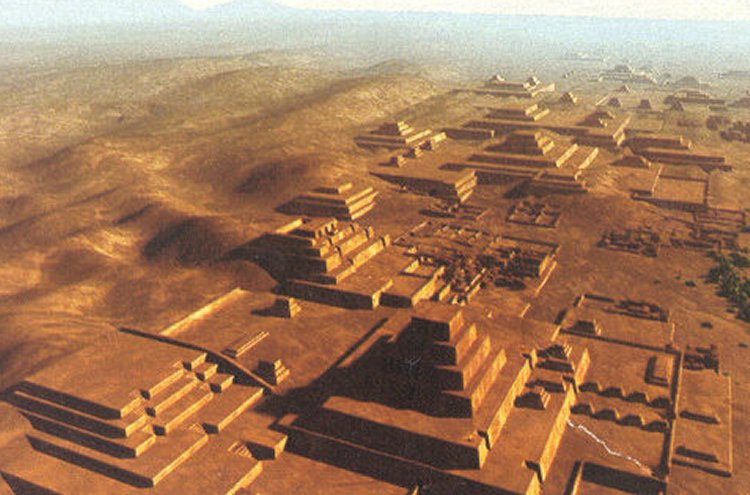A. Sutherland - AncientPages.com - Cahuachi - once the capital of the Nazca culture and a major ceremonial center from the period 450 BC- 450 AD - is located 30 km (19 miles) western of Nazca City, Peru. The site overlooked some of the Nazca lines.
The complex of truncated adobe pyramids built by the Nazcas features a patio and a wide terrace with covered rooms.
Cahuachi archaeological site in Peru. Image credit: Ed88 - CC BY-SA 2.5
This complex of truncated adobe pyramids built by the Nazcas features a patio and a wide terrace with covered rooms. On top of the main temples, huge rooms with dozens of columns were found.
The majority of these pyramids were abandoned during the fifth and sixth centuries A.D.
As a major proponent of research and preservation of the site, Italian archaeologist, Giuseppe Orefici, expresses concern over its future with the climate phenomenon of El Niño lurking on the horizon. He has been excavating and conducting research on the ceremonial site in Nazca, southern Peru, for the last couple of decades.
The site contains over 40 mounds topped with adobe structures. The huge architectural complex covers 0.6 sq. miles (1.5 km2).
Also, other archaeologists conducted extensive excavations of Cahuachi’s s ancient site. It was once believed that the site was the capital of the Nazca state but later archaeologists determined that the permanent population was quite small.
Later theories focused on the possibility that the ancient site was a pilgrimage center, whose population largely increased greatly due to major ceremonial events. New research has suggested that 40 of the mounds were natural hills modified to appear as artificial constructions.
Support for the pilgrimage theory comes from archaeological evidence of the sparse population at Cahuachi, the spatial patterning of the site, and ethnographic evidence from the Virgin of Yauca pilgrimage in the nearby Ica Valley.
According to Orefici, it’s the largest clay ceremonial center in the world. The place is 24 square kilometers long, located in the valley of the Nazca River, 460 kilometers south of Lima. It’s even larger than the pre-Colombian citadel of Chan Chan located in Trujillo, northern Peru.
According to the researcher, Cahuachi "is the most important center of the Nazca culture, which developed between 400 years before Christ and 400 years after Christ, and was used to make offerings related to agriculture", its main activity.
Orefici is in charge of a project, which will run until 2011, which consists of the enhancement of the monuments of the citadel with a budget of $ 250,000 per year.
The Italian Ministry of Foreign Affairs is the main contributor to the investigations carried out by Orefici. In Cahuachi, located 28 kilometers from the city of Nazca, you can find four large groups of buildings, delimited by a perimeter wall that encloses them, where the Great Pyramid, the Great Temple, the Stepped Temple and the Mounds stand out.
The front of the pyramid is 28 meters high and 100 meters long and inside there are seven stepped platforms.
The Peruvian conservator Angel Alfaro is in charge of rebuilding the walls because the adobe used in the original construction has conservation problems. Alfaro's work focuses on strengthening structures and replicating adobe bricks (made of mud and straw).
Orefici reported that walls have been found that were originally red in color, but now only retain some parts.
The team of archaeologists working in Cahuachi discovered in 1998 a deposit of 200 textiles, several of which were hand-painted, a rarity within the Nazca culture, of which only embroidered textiles were known until now.
In addition, they have found about twenty heads of children and adults, belonging to the same community, which were offerings to their gods.
All the remains that have been found in the tombs area are on display in the Antonini educational museum, which was built on a 4,200-meter site donated by the Nazca municipality to build laboratories, a conference room and an open-air archaeological park. 1,600 square meters.
In the archaeological park you can see reconstructions of tombs with imitations of burials and their funerary equipment, reproductions of cave paintings and a model of the huge geoglyphs in the Nazca desert.
The restoration work of the ceremonial center was dedicated this year to architecture and in 2005 they plan to advance in the conservation and in the excavations in the Stepped Temple and in the monumental walls of about 10,000 meters long.
Some mounds had rooms on top of them, but the majority of them are overwhelmingly never actual “habitation mounds”. Others are considered to be “temples,” and still others were used for burials.
Not only can El Niño seriously endanger Cahuachi but also systematic looting. Most of the burial sites surrounding Cahuachi were not known until recently and are tempting targets for looters.
The influence of Cahuachi reached the outskirts of the Tablada de Lurin (Lima), and to the east reached Huanuco, Huancayo (Junin), and Ayacucho, while to the south, it spread to the town of Acari (Arequipa).”
It is a large area and in the two decades of work, Orefici and his team have only excavated 1 percent of the entire 24 square km of the sanctuary.
Written by – A. Sutherland - AncientPages.com Senior Staff Writer
Copyright © AncientPages.com All rights reserved. This material may not be published, broadcast, rewritten or redistributed in whole or part without the express written permission of AncientPages.com
Expand for referencesReferences:
